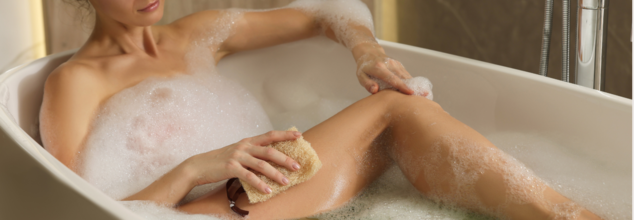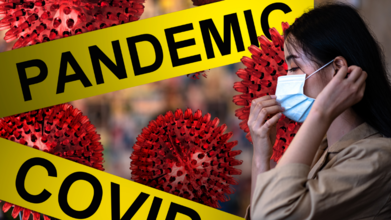- Health Conditions A-Z
- Health & Wellness
- Nutrition
- Fitness
- Health News
- Ayurveda
- Videos
- Medicine A-Z
- Parenting
- Web Stories
Do Feminine Hygiene Products Actually Cause Vaginal Infection?

Image credit: Canva
Feminine hygiene products are sold as agents to help women stay clean, fresh, and comfortable. From intimate washes and douches to scented pads and tampons, the scope of available products in the market promises to meet every woman's hygiene need. However, concerns have been rising lately about the safety of these products, some studies claiming that rather than promoting health, they can contribute to a heightened risk of vaginal infections.
A new study done by the University of Guelph in Ontario, Canada, has fueled this fear. The study asked more than 1,400 Canadian women about their use of feminine hygiene products, and the results were frightening. The study found that 95% of participants had used some type of over-the-counter hygiene product at least once, and importantly, those who used these products regularly were three times more likely to experience some type of vaginal infection.
While some hygiene products, like tampons and sanitary pads, are necessary and integral parts of the menstrual cycle, other products like vaginal washes, scented pads, and anti-itch creams are advertised to be necessary for feminine health. Do these products, which many women count on to keep themselves clean, cause harm?
The vagina is a self-cleaning organ that possesses a natural cleansing mechanism. The healthy condition of the vaginal environment is maintained by the presence of beneficial bacteria, primarily Lactobacillus, that maintains the pH balance and helps in preventing infections. If the fragile microbial ecosystem is disrupted, it causes many infections, such as BV, yeast infections, and UTIs.
Dr. Deepti Sureka, Urologist, says that vaginal anatomy needs to be grasped before the safety of hygiene products for women can be known. "The vagina is not meant to be over-cleaned or manipulated. Overuse of hygiene products, especially douches or scented products, may cause an imbalance in natural pH and lead to infection," says Dr. Sureka.
Common Feminine Hygiene Products and Their Risks
Vaginal washes and douches
Vaginal wash is one of the most widely used feminine hygiene products used by women in terms of freshness maintenance. These items, however contain chemicals, which can throw the vaginal flora out of its natural balance. Doctors have long since condemned douche as it leads to infections; the idea behind douching is not only to get rid of pathogens but also *Lactobacillus*, those beneficial bacteria of the vagina, making the vagina open to infections.
Fragrant Products
Most women prefer scented pads, tampons, and panty liners because they will not like the smell of the menstrual discharge. Unfortunately, the majority of these products contain synthetic fragrances and chemicals that are irritating to the very sensitive skin of the vaginal mucosa. Such irritation may become a breeding ground for infection, such as yeast and BV. For others, some may suffer from chemical sensitivities, which further complicates the condition.
Tampons
Tampons are a product that most women need to use when they menstruate. Tampons are relatively safe if used properly. However, leaving a tampon in for too long causes the growth of dangerous bacteria that can lead to TSS, a rare but potentially fatal condition. In addition, the synthetic materials used in some tampons may cause irritation in the vaginal area.
Menstrual Cups
Menstrual cups have become popular as an eco-friendly and sustainable alternative to tampons and pads. However, if they are not cleaned properly or used for too long, menstrual cups can increase the risk of vaginal infections. As with tampons, the risk arises when the cups are not sanitized adequately, and bacteria grow.
Panty Liners and Pads
Use panty liners regularly without actually knowing that they encourage an atmosphere with humidity that thrives on bacterial and fungal growth. The constant usage of pads for extended periods especially under humid conditions, puts more possibility of developing skin irritation and infection.
Application of fragrant scents compounds the risk of developing allergic reactions or irritation.
Habits Affecting Vaginal Health
Beyond the products themselves, it is how women use them that is key to preventing infections. Dr. Sureka advises women to be good about hygiene, changing pads and tampons regularly, thereby reducing bacterial buildup. "It's important to change tampons every 4-6 hours and avoid leaving them in for extended periods," she says.
Proper use of menstrual cups entails frequent sterilization, and hands should always be cleaned before insertion or removal. Excessive cleaning of the vagina, such as washing or scrubbing too frequently, can strip the skin of its natural oils and beneficial bacteria, which are necessary to maintain vaginal health.
How to Minimize the Risk of Vaginal Infections
While the risks associated with feminine hygiene products are concerning, there are a number of ways women can minimize the risk of infections:
1. Use Warm Water for Daily Hygiene
For most women, warm water is enough to clean the external genital area. If further cleaning is required, opt for a mild, fragrance-free soap, but do not use it inside the vagina.
2. Opt for Breathable Fabrics
Go for cotton undergarments and avoid wearing tight clothing that can retain moisture. Dry fabrics prevent the vaginal region from getting moist, thus avoiding bacteria or fungal infections.
3. Steer Clear of Fragrant Products
Using fragrance-free pads, tampons, and liners helps to reduce the amount of chemicals one is exposed to. Fragrant products tend to have artificial fragrances, which cause irritation of the vagina and may lead to allergic reactions.
4. Reduce the Use of Female Hygiene Products
Unless prescribed by a healthcare provider, avoid douching or using vaginal washes. The vagina is naturally self-cleaning, and overuse of these products can disrupt its pH balance and microbial environment.
5. Consult a Healthcare Provider
If you experience persistent irritation, unusual discharge, or symptoms of infection, it’s crucial to consult a healthcare provider or urologist promptly. Early intervention can prevent infections from escalating and help maintain vaginal health.
Feminine hygiene products can offer convenience, but when overused or misused, they can contribute to an increased risk of vaginal infections. Women must be informed about the potential risks associated with certain products and adopt healthier hygiene practices. Ultimately, understanding the natural functions of the body and avoiding unnecessary interference with that process is key to preventing infections and maintaining overall vaginal health.
Dr. Deepti Sureka is a Consultant Female Urologist at Asian Institute of Nephrology and Urology Hyderabad, India.
Vaginal health and hygiene practices and product use in Canada: a national cross-sectional survey. 2018. BMC Women's Health.
Feminine Hygiene - United States. 2024. Statistica
Can Wearing Black Undergarments Cause Breast Cancer? Expert Busts Breast Cancer-Related Myths

Credits: Canva
October is the Breast Cancer Awareness Month. Each year, the World Health Organization (WHO) observes this month to spread awareness on breast cancer and the month is also globally observed. This year, the theme is 'Every Story is Unique, Every Journey Matters'. The aim of this theme is to make more people understand that while community support is important, not everyone's journey can be the same. Each breast cancer diagnosis is personal.
Breast Cancer Statistics
Breast cancer is the most commonly diagnosed cancer among women worldwide. In 2022, approximately 2.3 million women were diagnosed and another 670,000 died from the disease, notes WHO.
WHO also notes that while the 5-year survival rates in high-income countries exceeds 90%, the figures drop to 66% in India and 40% in South Africa. These disparities are driven by unequal access to early detection, timely diagnosis and effective treatment. If the current trend continues, the incidence and mortality are projected to rise by 40% by 2050 hence the need for urgent and coordinated action. Indeed, where a woman lives should not determine whether she survives.
Established in 2021, the WHO Global Breast Cancer Initiative together with partners is working with countries to reduce breast cancer mortality by strengthening health systems.
The goal for this year's Breast Cancer Awareness Month thus would be to increase awareness and promote behavior change for early detection of the same.
One also must understand that the stigma and myths around breast cancer is what makes it difficult for people to understand what is happening with their body.
While the percentage of breast cancer patients is high in women, it is wrong to assume that men are not affected. Dr Mickey Mehta, previously told Health and Me, "Traditionally it is viewed as a women’s health issue, breast cancer awareness has often excluded men, even though they can also be affected by the disease. Engaging men in breast cancer awareness is crucial, as breast cancer can affect men, albeit at lower rates than women."
What Are Other Myths Associated With Breast Cancer?
Wearing A Bra Causes Breast Cancer
This idea was fueled by the 1995 book called Dressed to Kill by Sydney Ross Singer and Some Grismaijer which claimed that women who wear underwire bras for 12 hours a day have a much higher risk of developing breast cancer. The book claims that it restricts the lymph system, which can result in a build-up of toxins in the breasts. However, there is no credible research that shows a link between the two.
Dr Namrata Singal Sawant, Director and Senior Breast & Women's Imaging Consultant Radiologist at Vcare Imaging Diagnostic Centre, Mumbai, says, "While many of my patients ask me this question, especially about underwired bras or black bras; there has been no scientific evidence to claim the same. Although ill-fitting bras do cause chest pain or breast pain sometimes if too tight. But not cancer."
Sugar Consumption Can Caused Increased Risk of Breast Cancer
"It might be associated with many other health issues but has not been associated with breast cancer yet. However, keeping the sugar levels under control is very important for health healing of any breast infections or inflammatory disorders. Diabetic mastopathy is an important mimicker of breast cancer on imaging," says the doctor.
Wearing Black-dyed Clothes Can Cause Breast Cancer
The doctor says that it has not been proven by any scientific studies; however, wearing clothes with natural fibres and maintaining personal hygiene in the form of cleaning ourselves and our clothes regularly is a must.
Pregnancy Increases The Risk of Breast Cancer
As per the National Cancer Institute, the older a woman is when she has her first full-term pregnancy, the higher her risk of breast cancer. "Having our conventional reproductive customs like a first child before the age of 30 years and breastfeeding has been known to be associated with lower risks," says Dr Namrata. She also highlights the reports of Hormonal replacement therapy associated with increased risk of breast cancer.
Therefore, pregnancy does not increase the risk of breast cancer.
Breast Cancer Cannot Happen Again
"Well! Some types of breast cancer when diagnosed early have excellent prognosis to treatment. Whereas there are others especially “Triple-negative types” which are notorious for poor prognosis and recurrence. If the cancer is diagnosed late, or positive margins have been left behind during breast conservative treatment or some kind of treatment failure, there are definite chances of recurrence," explained the doctor.
'Frankenstein' Covid-19 Variant Now Detected In Montreal's Wastewater, Confirmed Authorities

Credits: Canva
“Frankenstein”, a new Covid-19 variant, has been detected in Montreal’s wastewater and is now spreading across Quebec, according to the Institut national de santé publique du Québec (INSPQ). Officially known as XFG, the subvariant is considered highly transmissible but not more severe than earlier Omicron strains.
What Is the Frankenstein Covid-19 Variant?
First identified in January 2025, the Stratus strain—officially classified under the XFG lineage and its subvariant XFG.3—has become the most common form of COVID-19 in England.
The World Health Organization (WHO) has designated Stratus as a "variant under monitoring," a classification that signals the need for heightened genomic tracking, though it has emphasized the variant currently poses a low risk to global public health.
What sets Stratus apart from prior variants, particularly its Omicron predecessors, is a peculiar but increasingly common symptom: a hoarse or raspy voice, an anomaly not prominently associated with COVID-19 strains before.
Stratus is not just another offshoot of Omicron; it is what scientists call a “recombinant” or “Frankenstein” variant. This means it emerged when an individual was infected with two different Covid strains simultaneously, resulting in a new hybrid lineage. Such recombination events are rare but can lead to variants with novel characteristics—including changes in transmissibility, immune evasion, and symptomatology.
Reports from the World Health Organization indicate that Stratus is showing signs of additional immune evasion compared to other strains. This means it may more effectively bypass existing immunity from previous infections or vaccinations, contributing to its rapid spread.
Symptoms to Watch For
Like other Omicron subvariants, XFG is associated with respiratory symptoms such as dry cough, fatigue, nasal congestion, headache, muscle aches, and fever.
However, clinical observations point to some distinctive signs:
- A hoarse voice often accompanied by a sore throat described as a “razor blade” sensation.
- Some patients also experience gastrointestinal issues such as nausea and diarrhea, though these cases remain less common.
Risks Remain Moderate
WHO has classified XFG as a “variant of concern” but stresses that current data does not show it causes more severe illness compared to previous strains. Available vaccines are expected to continue providing strong protection against both symptomatic and severe cases.
Still, Canada is seeing a rise in overall COVID-19 activity. Federal data shows more than 2,400 confirmed cases were reported in the week of September 20, with positivity rates exceeding 10%. Activity is particularly increasing among people aged 65 and older.
In Quebec, health officials describe the situation as “moderate but rising”, aligning with what experts describe as part of the virus’s natural resurgence.
The Global Context: A 15th Wave in France
Canada’s developments mirror rising COVID-19 levels in Europe. French health experts say the country has entered a 15th wave, with incidence rates and emergency room visits climbing sharply since early September. Epidemiologist Mircea Sofonea explains that XFG carries multiple mutations that make it more transmissible and capable of partially evading immunity from prior infections or vaccines.
“The problem is that immunity naturally decreases over time, and these mutations help the virus bypass it,” Sofonea told franceinfo.
COVID-19 Entering a New Phase
Experts believe COVID-19 may be transitioning toward becoming a seasonal virus, much like the flu. “We hope that by next year, circulation will be more seasonal and less constant,” said Denis Malvy, infectious disease specialist at Bordeaux University Hospital.
How Do These New FDA-Approved Eyeglasses Treat Myopia?

Credits: Canva
The US Food and Drug Administration (FDA) has now approved the marketing of Essilor Stellest eyeglass lenses. It is now approved as a new treatment option designed to both correct myopia, which is nearsightedness and slow its progression in children between age 6 to 12.
What Is Myopia?
As pr the National Eye Institute, USA, nearsightedness is a refractive error that makes far-away objects look blurry. It happens when the shape of the eye makes light focus in front of the retina, which is a light sensitive layer of tissue in the back of your eye, instead of on it.
Myopia is also one of the most common vision conditions affecting children, and starts to worsen during the school years, when eyes are still growing. If left unchecked, progressive myopia can increase the risk of serious eye problems in adulthood, including retinal detachment, glaucoma, and early cataracts. Until now, the only FDA-authorized device for slowing myopia progression was a type of contact lens for children between 8 and 12 years old. Essilor Stellest lenses expand treatment to younger children, including those as young as six, and to those who may be unable or unwilling to wear contact lenses.
How Does The Lenses Work?
Unlike standard eyeglasses, these FDA-approved glasses have a unique design that allows a clear 9-millimeter central zone that corrects vision. It is also surrounded by multiple rings of small, raised lenslets. These lenslets create a “peripheral light defocus” effect, which alters how light focuses on the retina. Research suggests that this helps slow the abnormal eye growth associated with worsening myopia.
What Did The Studies Find?
The FDA’s decision was based on a clinical trial comparing Essilor Stellest lenses with conventional single-vision lenses. After 24 months, results showed:
- A 71 percent reduction in myopia progression (measured by spherical equivalent refraction).
- A 53 percent reduction in eye elongation (measured by axial length, an indicator of worsening myopia).
Importantly, no serious safety issues were reported. Some children experienced mild visual disturbances such as halos or blurriness, but these side effects were not considered severe.
A Safer and Easier Option
Experts emphasize that this approval offers families a practical, lower-risk alternative to contact lenses. Eyeglasses are generally easier for young children to manage, reducing risks of infection or misuse that can occur with contacts.
“Today’s authorization brings to market a treatment option that may meaningfully reduce the likelihood of severe eyesight issues later in adult life, while also being easier to use and lower risk than the currently authorized devices,” said Dr. Michelle Tarver, director at the FDA’s Center for Devices and Radiological Health.
© 2024 Bennett, Coleman & Company Limited

